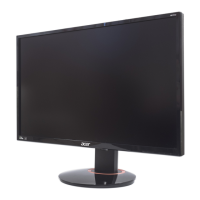10
1.2.3 Defect Terminology:
Dark Spots / Lines: Spots or lines that appear dark in the display patterns and are usually the result of
contamination. Defects do not vary in size or intensity (contrast) when contrast voltage is varied. Contrast
variation can be achieved through the use of varying gray shade patterns.
Bright Spots / Lines: Spots or lines that appears light in the display patterns. Defects do not vary in size or
intensity (contrast) when contrast voltage is varied. Contrast variation can be achieved through the use of
varying gray shade patterns.
Polarizer Scratch: When the unit lights, lines appear light (white) with display patterns dark and do not
vary in size. Physical damage to the polarizer does not damage the glass.
Polarizer Dent: When the unit lights, spots appear light (white) with display patterns dark and do not vary
in size. Physical damage to the polarizer does not damage the glass.
Rubbing Line: Horizontal or diagonal lines that appear gray with the display patterns dark and may have
resulted from an “out of control” rubbing process on the polyimide or “waves” on the BEFs or prism sheets .
Newton Ring: The “rainbow” effect caused by non-uniform cell thickness.
Mottling: When the unit lights, variation / non - uniformity (splotch) appears light (white) with the display
and might vary in size.
Dim Line: When the unit lights, line(s) in the minor (vertical) or major (horizontal) axis appear dim, but not
completely on or off.
Cross Lines Off: When the unit lights , lines in both the minor and major axis do not appear.
Bright/Dark Dot: A sub - pixel (R, G, B dot) stuck off / on (electrical).
1.2.4 Optical Characteristics:
Note 1 Measurement method
The LCD module should be stabilized at given temperature for 30 minutes to avoid abrupt temperature change
during measuring (at surface 35℃). In order to stabilize the luminance, the measurement should be executed
after lighting Backlight for 30 minutes in a stable, windless and dark room.
Note 2 Definition of Viewing Angle (x, y):
Viewing angle is the measurement of contrast ratio ≧10, at the screen center, over a 180° horizontal and
180° vertical range (off-normal viewing angles). The 180° viewing angle range is broken down as follows;
90° () horizontal left and right and 90° () vertical, high (up) and low (down). The measurement direction is
typically perpendicular to the display surface with the screen rotated about its center to develop the desired
measurement viewing angle.

